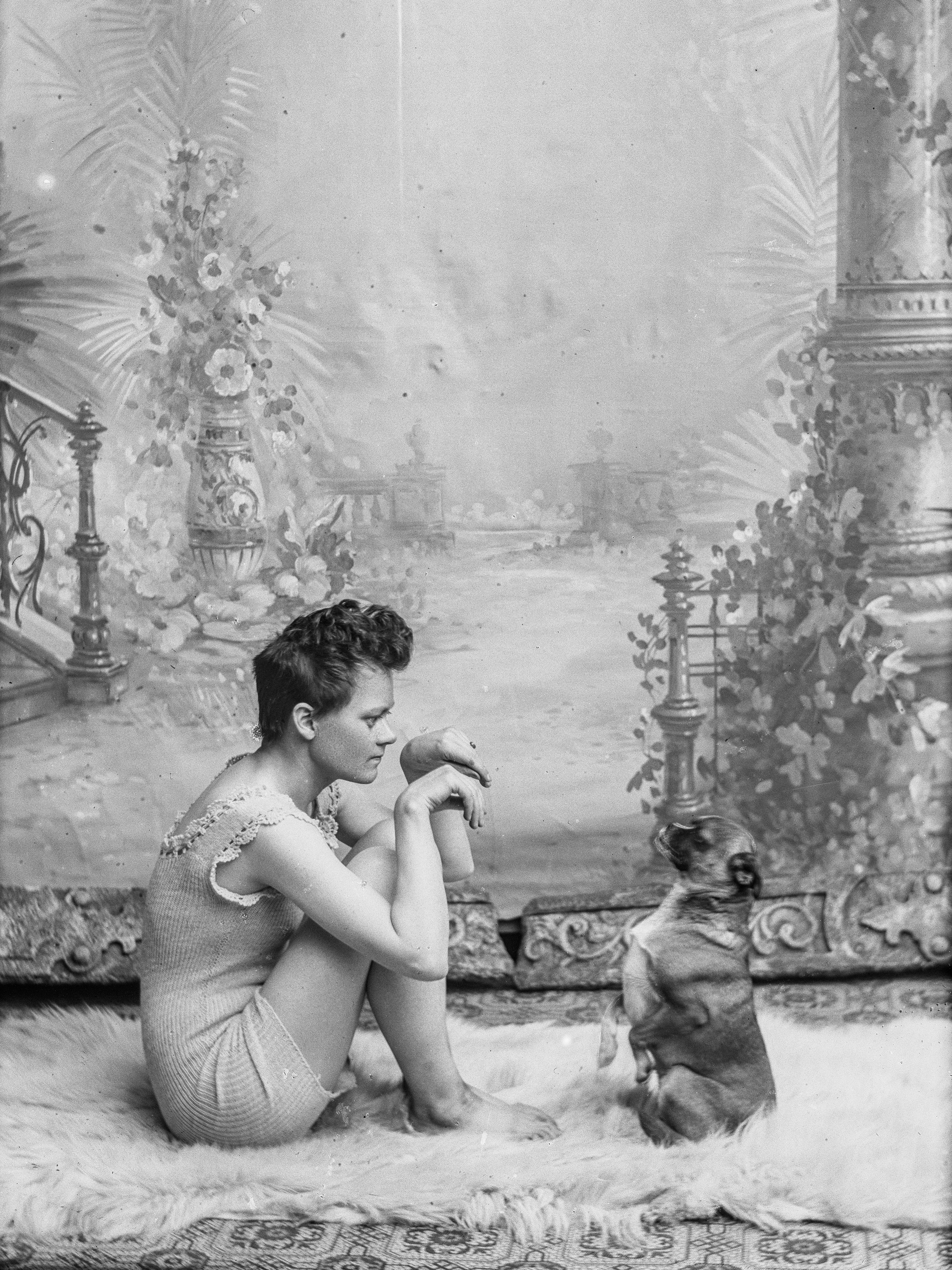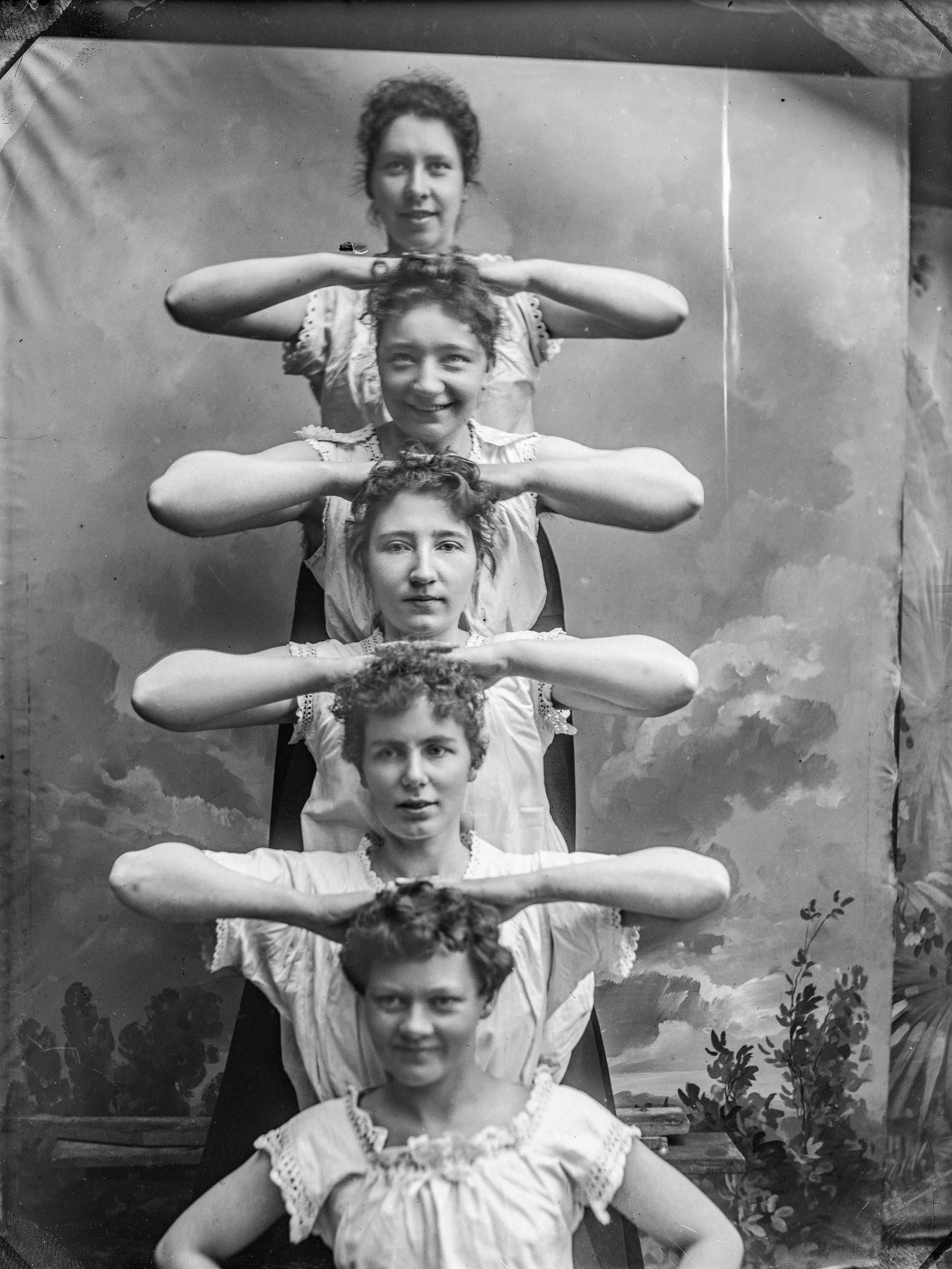f³ – freiraum für fotografie | Berlin
13. Juni 2024
Grußwort: Else Kveinen, Botschaft srätin, Kgl. Norwegische Botschaft , Berlin.
Es sprechen: Cecilie Øien, Direktorin Preus Museum und Kristin Aasbø, Leiterin Sammlung Fotografie Preus Museum.
LIKE A WHIRLWIND – Die Genderplays von Marie Høeg & Bolette Berg
Berg & Høeg, Marie Høeg beim Flirten, 1895–1903 © Sammlung des Preus Museums
Die Ausstellung LIKE A WHIRLWIND – Die Genderplays von Marie Høeg & Bolette Berg präsentiert einzigartige Crossdressing-Aufnahmen des späten 19. und frühen 20. Jahrhunderts.
Die Fotografinnen Bolette Berg und Marie Høeg gründeten 1894 das Fotostudio Berg & Høeg in der südnorwegischen Stadt Horten. Das Paar verbrachte sein gesamtes Erwachsenenleben damit, zusammen zu arbeiten und zu leben. Ihre recht konventionellen Portrait- und Landschaftsfotografien veröffentlichten sie als Postkarten. Zu internationalem Ruhm gelangten die Norwegerinnen posthum durch ihre frühen fotografischen Experimente mit Geschlechterrollen, die wohl zurecht als erste so komplexe fotografische Auseinandersetzung mit dem Thema Crossdressing gelten.
Bei der Versteigerung ihres Nachlasses in den 1970er Jahren erwarb der norwegische Sammler Leif Preus die Glasnegative der beiden Fotografinnen. Neben Aufnahmen von Landschaften und Reproduktionen von Kunstwerken befanden sich zwei Kisten, die mit dem Hinweis „privat“ versehen waren und Marie Høeg, Bolette Berg sowie ihre Geschwister und Freund*innen beim Posieren vor der Kamera zeigen. Mit traditioneller Portraitfotografie hatten diese Aufnahmen nichts gemein. Die spielerisch, humorvoll und voller Lebensfreude komponierten Fotografien stellen die Weiblichkeitsideale des 19. und frühen 20. Jahrhunderts sowie die Geschlechterrollen der damaligen Zeit radikal und frech in Frage. Erstaunlich ist die Aktualität der Bildsprache und die visuelle Auseinandersetzung mit dem Thema, die mit zeitgenössischer künstlerischer Praxis vergleichbar ist. Witzig und frisch nehmen die beiden Fotografinnen Stereotype auf und verwandeln sie mithilfe von Requisiten und Kostümen in frivole Fotografien.
Die moderne Herangehensweise der Fotograf*innen zeugt von Selbstbewusstsein, von einer spielerischen Auseinandersetzung mit gesellschaftlichen Normen; gleichzeitig macht der Nachlass deutlich, dass die Aufnahmen zu ihren Lebzeiten nur für den Privatgebrauch, nicht für die Öffentlichkeit, bestimmt waren. Das fotografische Atelier war der Safe Space, der sichere Ort, an dem sich die Protagonist*innen der Bilder selbstbestimmt präsentieren konnten.
Das Preus Museum, das norwegische Nationalmuseum für Fotografie e, verwaltet den Nachlass von Marie Høeg und Bolette Berg und besitzt die Original-Glasnegative in seiner Sammlung. Die Ausstellung im f³ – freiraum für fotografie zeigt digitale Reproduktionen dieses einzigartigen Materials, das in Deutschland so erstmalig zu sehen sein wird.
Berg & Høeg, Marie Høeg als Junge gekleidet, 1895–1903 © Sammlung des Preus Museums
L'exposition LIKE A WHIRLWIND - Les Genderplays de Marie Høeg & Bolette Berg présente des photos de travestissement uniques de la fin du 19e et du début du 20e siècle.
Les photographes Bolette Berg et Marie Høeg ont fondé en 1894 le studio photo Berg & Høeg dans la ville de Horten, au sud de la Norvège. Le couple a passé toute sa vie d'adulte à travailler et à vivre ensemble. Ils publièrent leurs photographies de portraits et de paysages assez conventionnelles sous forme de cartes postales. Les Norvégiennes ont acquis une renommée internationale à titre posthume grâce à leurs premières expériences photographiques sur les rôles de genre, considérées à juste titre comme la première approche photographique aussi complexe du thème du travestissement.
Lors de la vente aux enchères de leur héritage dans les années 1970, le collectionneur norvégien Leif Preus a acquis les négatifs sur verre des deux photographes. Outre des clichés de paysages et des reproductions d'œuvres d'art, il y avait deux boîtes portant la note "privé" et montrant Marie Høeg, Bolette Berg ainsi que leurs frères et sœurs et leurs amis* posant devant l'objectif. Ces photos n'avaient rien de commun avec la photographie de portrait traditionnelle. Composées de manière ludique, humoristique et pleine de joie de vivre, ces photographies transmettent une remise en question radicale et insolente des idéaux de féminité du 19e et du début du 20e siècle ainsi que des rôles sexuels de l'époque. Ce qui est étonnant, c'est l'actualité du langage visuel et la confrontation visuelle avec le thème, comparable à la pratique artistique contemporaine. Avec humour et fraîcheur, les deux photographes reprennent des stéréotypes et les transforment en photographies frivoles à l'aide d'accessoires et de costumes.
L'approche moderne des photographes* témoigne d'une confiance en soi, d'une confrontation ludique avec les normes sociales ; en même temps, l'héritage montre clairement que les prises de vue n'étaient destinées, de leur vivant, qu'à un usage privé et non public. L'atelier photographique était le safe space, le lieu sûr où les protagonistes* des visuels pouvaient se présenter de manière autodéterminée.
Le Preus Museum, le musée national norvégien de la photographie e, gère l'héritage de Marie Høeg et Bolette Berg et possède les négatifs sur verre originaux dans sa collection. L'exposition au f³ - freiraum für fotografie présente des reproductions numériques de ce matériel unique, qui sera ainsi exposé pour la première fois en Allemagne.
Berg & Høeg, Marie Høeg spielt mit dem Hund Tuss, 1895–1903 © Sammlung des Preus Museums
La mostra LIKE A WHIRLWIND - The Genderplays of Marie Høeg & Bolette Berg presenta fotografie uniche di travestiti della fine del XIX e dell'inizio del XX secolo.
Le fotografe Bolette Berg e Marie Høeg fondarono lo studio fotografico Berg & Høeg nella città di Horten, nel sud della Norvegia, nel 1894. La coppia trascorse l'intera vita adulta lavorando e vivendo insieme. Pubblicarono le loro fotografie di ritratti e paesaggi piuttosto convenzionali come cartoline. I norvegesi raggiunsero fama internazionale postuma grazie ai loro primi esperimenti fotografici sui ruoli di genere, che sono probabilmente considerati a ragione come la prima esplorazione fotografica così complessa del tema del cross-dressing.
Quando il loro patrimonio fu messo all'asta negli anni Settanta, il collezionista norvegese Leif Preus acquistò i negativi su vetro dei due fotografi. Oltre a fotografie di paesaggi e riproduzioni di opere d'arte, c'erano due scatole etichettate come "private" che mostravano Marie Høeg, Bolette Berg e i loro fratelli e amici in posa davanti alla macchina fotografica. Questi scatti non hanno nulla in comune con la tradizionale fotografia di ritratto. Le fotografie, giocose, umoristiche e gioiosamente composte, mettono radicalmente e sfacciatamente in discussione gli ideali di femminilità del XIX e dell'inizio del XX secolo e i ruoli di genere dell'epoca. L'attualità delle immagini e l'esplorazione visiva del tema, paragonabile alla pratica artistica contemporanea, è sorprendente. I due fotografi riprendono gli stereotipi in modo spiritoso e fresco e li trasformano in fotografie frivole con l'aiuto di oggetti di scena e costumi.
L'approccio moderno dei fotografi testimonia la loro fiducia in se stessi e il confronto giocoso con le norme sociali; allo stesso tempo, la proprietà chiarisce che le fotografie erano destinate solo a un uso privato durante la loro vita, non al pubblico. Lo studio fotografico era lo spazio sicuro, il luogo sicuro in cui i protagonisti delle immagini potevano presentarsi in modo autodeterminato.
Il Preus Museum, il Museo Nazionale Norvegese della Fotografia, gestisce la proprietà di Marie Høeg e Bolette Berg e possiede i negativi originali in vetro della sua collezione. La mostra al f³ - freiraum für fotografie presenta riproduzioni digitali di questo materiale unico, che sarà esposto per la prima volta in Germania.
Berg & Høeg, Bolette und Marie spielen mit Freundinnen, 1895–1903 © Sammlung des Preus Museums
The exhibition LIKE A WHIRLWIND – The Gender Plays by Marie Høeg & Bolette Berg presents unique cross-dressing photographs from the late 19th and early 20th centuries.
The photographers Bolette Berg and Marie Høeg founded the Berg & Høeg photo studio in the southern Norwegian town of Horten in 1894. The couple spent their entire adult lives working and living together. They published their fairly conventional portrait and landscape photographs as postcards. The Norwegians achieved international fame posthumously through their early photographic experiments with gender roles, which are probably rightly regarded as the first such complex photographic examination of the subject of cross-dressing.
When their estate was auctioned off in the 1970s, the Norwegian collector Leif Preus acquired the glass negatives of the two photographers. In addition to photographs of landscapes and reproductions of artworks, there were two boxes labeled "private" showing Marie Høeg, Bolette Berg and their siblings and friends posing in front of the camera. These shots had nothing in common with traditional portrait photography. Playful, humorous and full of joie de vivre, the photographs radically and cheekily question the ideals of femininity of the 19th and early 20th centuries as well as the gender roles of the time. The topicality of the imagery and the visual exploration of the theme, which is comparable to contemporary artistic practice, is astonishing. The two photographers take up stereotypes in a witty and fresh way and transform them into frivolous photographs with the help of props and costumes.
The modern approach of the photographers testifies to their self-confidence and a playful examination of social norms; at the same time, the estate makes it clear that the photographs were only intended for private use during their lifetime, not for the public. The photographic studio was the safe space, where the protagonists of the pictures could present themselves in a self-determined manner.
Th e Preus Museum, the Norwegian National Museum of Photography, manages the estate of Marie Høeg and Bolette Berg and owns the original glass negatives in its collection. Th e exhibition at f³ – freiraum für fotografie shows digital reproductions of this unique material, which will be on display in Germany for the first time.
(Text: f³ – freiraum für fotografie, Berlin)




